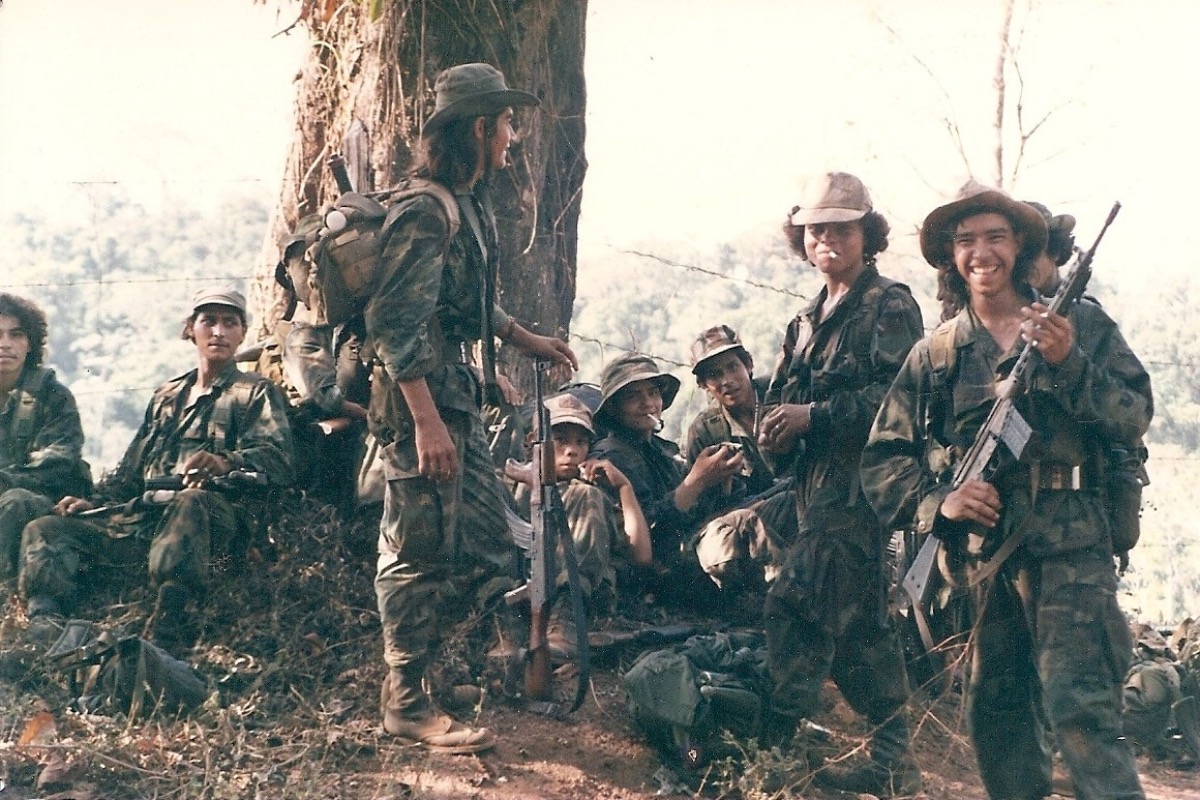

ARDE Frente Sur Commandos take a smoke break after routing FSLN base at El Serrano. Southeast Nicaragua 1987. (Creative Commons)
By Ricardo Chavira
The following is an excerpt from ‘We Were Always Here: A Mexican American’s Odyssey’ by Ricardo Chavira, shared courtesy of Arte Público Press.
Desperately, the heavily armed guerrillas and I scaled a steep, verdant hill in northern Nicaragua. In withering afternoon heat, the very fatigued 27 rebels, my colleague and I pressed on at a grueling pace, often slipping and stumbling on loose soil. For the last hour, the muffled boom of Nicaraguan military artillery told the fighters their enemies were close. Vastly outnumbered, the guerrillas had to keep moving.
The group’s mustachioed 29-year-old commander, Alfa, looked over his shoulder, his face tightened in fear and anger. “They are bombing where we just were. If we don’t hurry and get out of here, they’ll be on top of us.”
Alfa and his young, American-trained and -armed Nicaraguan peasants were Contras, that is contrarevolucionarios, or counterrevolutionaries. They were locked in a three-year-old war with the leftist Sandinista government. The group included two women combatants, photographer Bob Nickelsburg and me. Both Bob and I were on assignment for Time magazine.
Weeks earlier, Alfa and his fellow combatants had engaged in a raid from their Honduran base into Nicaragua’s Nueva Segovia Department, blowing up electrical power lines, mining roads, fighting Sandinista troops and murdering two civilian government collaborators. Now, on Good Friday, 1984, the Contras were again in Nueva Segovia being chased by insurgents with murderous intent. The rules of this war dictated that captured fighters were immediately often executed.
I was terrified yet focused on returning to the safety of the Honduran border, some 20 miles to the north. Strangely, I was struck by the improbability of my dire situation. I thought of the great physical, intellectual and emotional distance I had traveled to be at this torrid, dangerous spot in Nicaragua. To this day, I don’t understand why such thoughts came to me. My journey had begun some 25 years earlier as a poor Mexican boy in Southern California.
That journey would imbue me with a strong sense of dual identities, one Mexican, the other American. This biculturalism would enable me to navigate and understand the very different worlds and cultures of Mexico and the United States. As a journalist, I would view and interpret the world from the perspective of the poor, and my long immersion in Mexican culture allowed me to perceive Latin America as few Americans could.
When I was in Latin America, my Latino appearance allowed me to blend in. Then, as now, American journalists were overwhelmingly Euro-Americans, or we can say, simply middle-class white people, who grew up with the privileges afforded to those who lived in mainstream America. They could not see the world as I did. I found this was true even of white reporters who spoke fluent Spanish.
My experience would be filled with journalistic adventures in dozens of nations, including the Soviet Union, Vietnam and much of the Middle East. I would enjoy a first-hand view of historic events.
That years-long voyage would demand that I overcome the obstacles of poverty, racism and a dysfunctional family. I had struggled through high school, rejected gang affiliation, avoided committing serious crimes, evaded the Vietnam war draft and earned bachelor’s and master’s degrees. In my early twenties, I sometimes let myself dream of becoming a foreign correspondent for a top-tier American periodical. But I could not truly believe I would realize that dream.
Mine was an uncommon odyssey, since most Mexicans in the United States of my generation typically did not attend college. Sometimes I felt my goal of becoming a professional journalist was unrealistic. I was discouraged because there were only a handful of Latinos in mainstream English-language journalism. Institutional racism was an imposing barrier for those of us who were not white men. Even after I made my way into a newsroom, I fought to keep from being pigeon-holed as a “Hispanic” reporter. I was a journalist who happened to be Mexican —a mestizo comprised of European, indigenous Mexican and African ancestry— fully capable of reporting any story, including those that benefited from my Latino perspective and intimate knowledge of my American homeland.
I eventually earned the respect and trust of my colleagues and bosses at several news organizations and took on stories ranging from Los Angeles city hall to Mexico’s Palacio Nacional, the U.S.-Mexico border, Central American wars, historic summits and American diplomatic affairs in Washington, D.C. As I reported and edited stories of every sort, traveling to more than 40 nations, I would earn awards, including the 1994 Pulitzer Prize for international reporting.
I found that my profound identification with my Mexican heritage and the poor set me apart from most American journalists of my time, who I saw as privileged white people. Of course, I could not know that my Nicaraguan predicament would provide a dramatic chapter in my growth as a journalist. Nor could I imagine Central America and its poor would remain a U.S. foreign policy concern well into the 2000s. I would witness how Washington’s support for repressive regimes would set in motion the current mass exodus of Central Americans to the US-Mexico border.
Click here for more about We Were Always Here: A Mexican American’s Odyssey by Ricardo Chavira (Arte Público Press, 2021)
***
Ricardo Chavira is a Pulitzer Prize-winning Mexican-American journalist with over 40 years of experience. He was born and raised in Pacoima, California.


